Do LLMs dream of Type Inference?
Leaner Technologies, Inc.
Shunsuke "Kokuyou" Mori
@kokuyouwind
$ whoami
Name: Shunsuke Mori
Handle: Kokuyou (黒曜)

from Japan 🇯🇵
(First time in the US / at RubyConf)
Work: Leaner Technologies, Inc.
Hobby Project:
Developing an LLM-based type inference tool


@kokuyouwind
@kokuyouwind
Why Type Inference with LLMs?
class Bird; end
class Duck < Bird
def cry; puts "Quack"; end
end
class Goose < Bird
def cry; puts "Gabble"; end
end
def make_sound(bird)
bird.cry
end
make_sound(Duck.new)
make_sound(Goose.new)What is the argument type of make_sound method?
Traditional Approach: Algorithmic
make_sound(Duck.new)
make_sound(Goose.new)Called with Duck
Called with Goose
The argument type of make_sound is (Duck | Goose)
Human Approach: Heuristics
class Bird; end
def make_sound(bird)
bird.cry
endThe argument name is bird.
The argument type of make_sound is Bird
There is Bird class.
Algorithms are great at logic, but lack heuristic understanding.
LLMs offer the potential for human-like type inference.

I developed
as a tool to guess RBS types using LLMs.
RBS Goose
Generate RBS type definitions from Ruby code using LLMs
(Presented at RubyKaigi 2024)
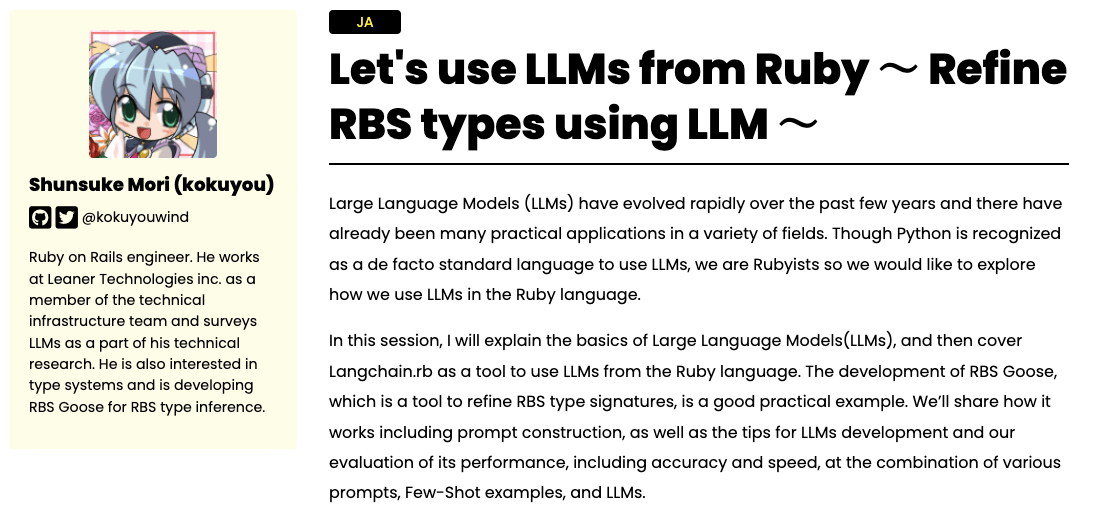

Duck

quacking like geese
Duck

quacking like geese
Duck

Duck Typing
quacking like geese
Goose
RBS Goose: Current State
Ruby
RBS

some small
:

How capable is

:

?
We will need some metrics of RBS Goose performance.
Previous Research
-
Ruby SimTyper: Research of type inference
-
Covers several libraries and Rails Applications
-
Not directly available due to different type formats
-
-
Python TypeEvalPy: Type Inference Micro-benchmark
-
Covers grammatical elements / typing context
-
Previous Research
A lot of papers exists... on Python🐍
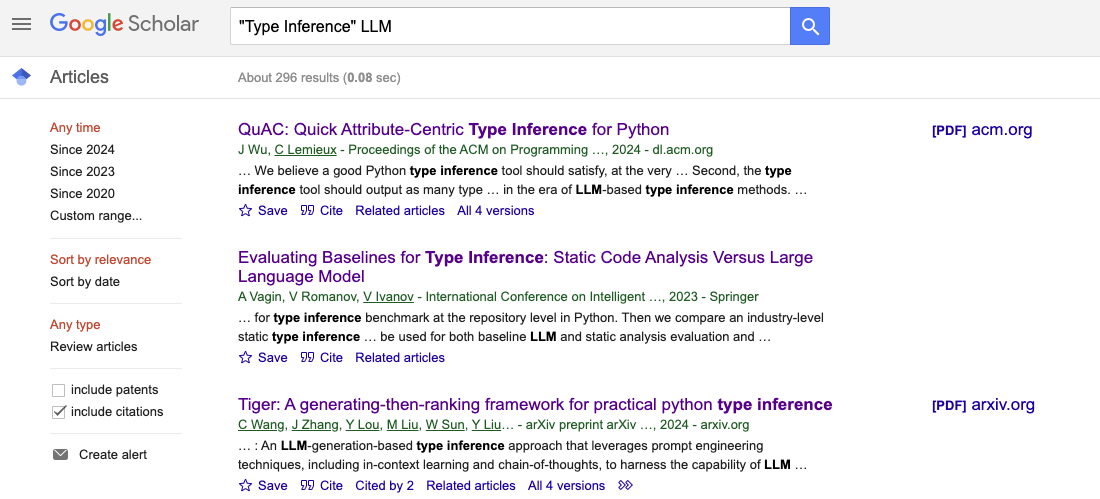
-
Explain how RBS Goose works with LLM and evaluate
-
Better results than traditional methods in several cases
-
-
Share the idea of a type inference benchmark I planned
-
Referring to previous studies
-
Today's Focus
Outline
Basics of Type System and Type Inference
RBS Goose Architecture and Evaluation
Evaluation Method in Previous Studies
The idea of TypeEvalRb
Conclusion
Outline
Basics of Type System and Type Inference
RBS Goose Architecture and Evaluation
Evaluation Method in Previous Studies
The idea of TypeEvalRb
Conclusion
Type System
-
A mechanism to classify the components of a program
-
Strings, numbers, etc.
-
To prevent invalid operations
-
-
Ruby is a dynamically typed language
-
1 + 'a': TypeError is raised at runtime -
1 + 'a' if false: TypeError is not raised
-
Static Type Checking
-
A mechanism to detect type errors before execution
-
Need to know the type of each part of the code
-
Ruby does not use type annotations in its code
-
Define types with RBS / Checking with Steep
-
(Other options include RBI / Sorbet, and RDL, but we will not cover in this session)
-
Static Type Checking: Examples
-
For
1 + 'a', we can detect a type error if we know...-
1is anInteger -
'a'is aString -
Integer#+cannot accept a String
-
class Integer
def +: (Integer) -> Integer
# ...
endType Inference
-
Mechanism to infer types of code without explicit annotations
-
For performing static type checks
-
To generate types for Ruby code without type definitions
-
-
TypeProf: Ruby / RBS type inference tool
-
Tracking data flow in variable assignments and method calls
(Dataflow Analysis)
-
TypeProf: Mechanism
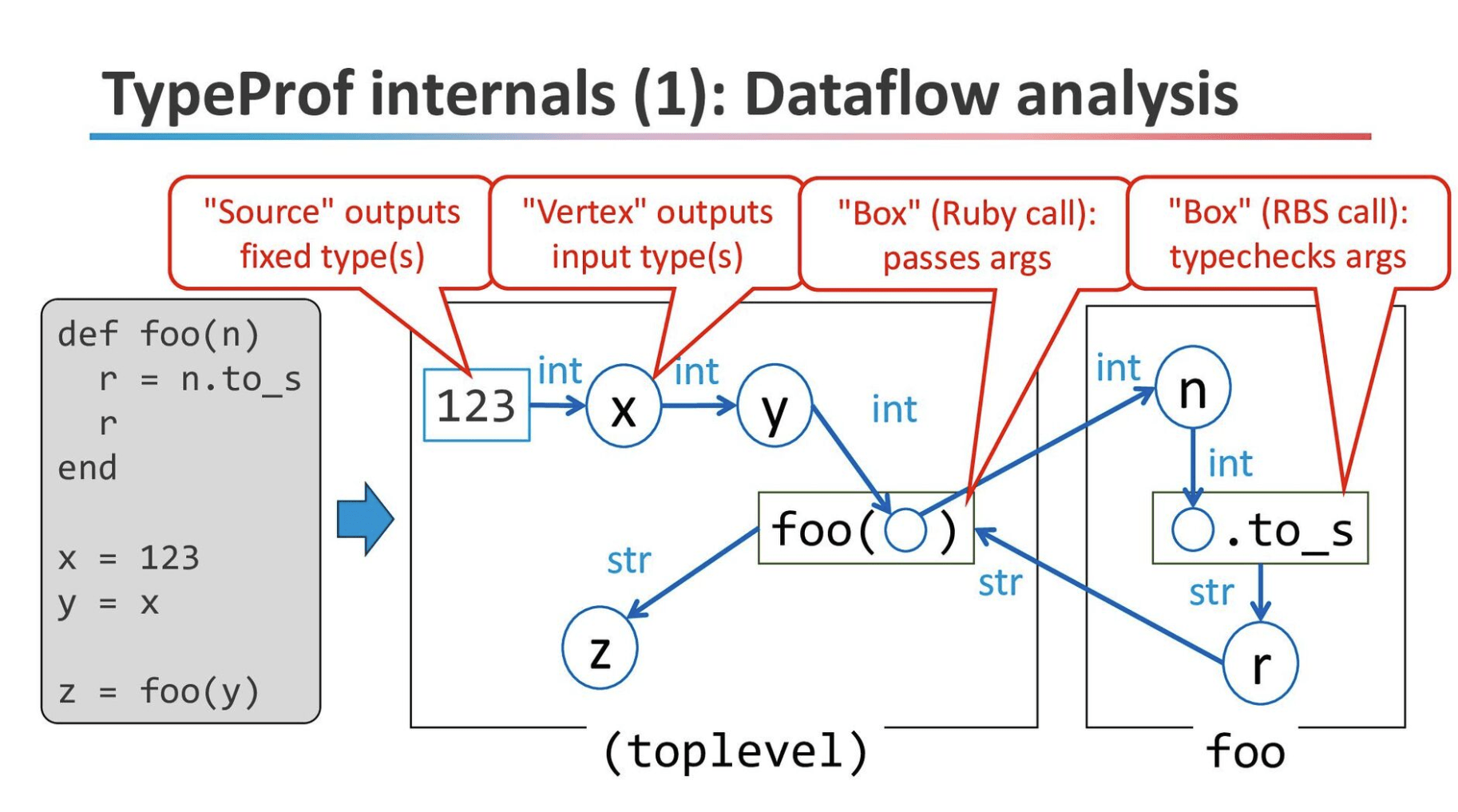
def foo: (Integer n) -> StringTricky Case - Generalization
class Bird; end
class Duck < Bird
def cry; puts "Quack"; end
end
class Goose < Bird
def cry; puts "Gabble"; end
end
def make_sound(bird)
bird.cry
end
make_sound(Duck.new)
make_sound(Goose.new)class Bird
end
class Duck < Bird
def cry: -> nil
end
class Goose < Bird
def cry: -> nil
end
class Object
def make_sound: (Duck | Goose) -> nil
endlib/bird.rb
sig/bird.rbs
The argument type of make_sound is
infered as a union of subtypes.
TypeProf
Tricky Case - Dynamic definition
class Dynamic
['foo', 'bar'].each do |x|
define_method("print_#{x}") do
puts x
end
end
end
d = Dynamic.new
d.print_foo #=> 'foo'
d.print_bar #=> 'bar'class Dynamic
endlib/dynamic.rb
sig/dynamic.rbs
[error] undefined method: Dynamic#print_foo
[error] undefined method: Dynamic#print_bar
TypeProf
Summary - Basics of Type System and Type Inference
-
Type System: prevent invalid operation of the program
-
Ruby has a dynamic type system
-
-
Static Type Checking: detect type errors before execution
-
Type description language (e.g. RBS) are used
-
-
Type Inference: Infer types of codes without type annotations
-
Traditional methods usually work well,
but are not good at generalization, dynamic definition, etc.
-
Since LLM imitates human thinking,
so it may work well in these cases.
Outline
Basics of Type System and Type Inference
RBS Goose Architecture and Evaluation
Evaluation Method in Previous Studies
The idea of TypeEvalRb
Conclusion
RBS Goose

class Bird; end
class Duck < Bird
def cry; puts "Quack"; end
end
class Goose < Bird
def cry; puts "Gabble"; end
end
def make_sound(bird)
bird.cry
end
make_sound(Duck.new)
make_sound(Goose.new)class Bird
end
class Duck < Bird
def cry: () -> void
end
class Goose < Bird
def cry: () -> void
end
class Object
def make_sound: (Bird arg) -> void
end
lib/bird.rb
sig/bird.rbs
Generate RBS type definitions from Ruby code using LLMs
LLM execution example (ChatGPT)

Prompt (Input Text)
Output Text
LLM Technique: Few-shot Prompting
Few-shot Prompt
(provide some examples)
Zero-shot Prompt
(provide no examples)
(Prompt)
Answer color code.
Q: red
A: #FF0000
Q: blue
A:
(Output)
#0000FF(Prompt)
Answer color code for blue.
(Output)
The color code for blue depends on the system you're using:
HEX: #0000FF
RGB: (0, 0, 255)
CMYK: (100%, 100%, 0%, 0%)
HSL: (240°, 100%, 50%)
Pantone: PMS 2935 C (approximation)
Would you like codes for a specific shade of blue?RBS Goose Architecture


Ruby
RBS
Refined RBS
rbs prototype
examples
Prompt
LLM
(e.g. ChatGPT)
Step.1 Generate RBS prototype


Ruby
RBS
Refined RBS
rbs prototype
examples
Prompt
LLM
(e.g. ChatGPT)
class Bird
end
class Duck < Bird
def cry: () -> untyped
end
class Goose < Bird
def cry: () -> untyped
end
class Object
def make_sound: (untyped bird) -> untyped
endsig/bird.rbs
RBS Goose Architecture


Ruby
RBS
Refined RBS
rbs prototype
examples
Prompt
LLM
(e.g. ChatGPT)
class Example1
attr_reader :quantity
def initialize(quantity:)
@quantity = quantity
end
def quantity=(quantity)
@quantity = quantity
end
end
lib/example1.rb
class Example1
@quantity: untyped
attr_reader quantity: untyped
def initialize: (quantity: untyped) -> void
def quantity=: (untyped quantity) -> void
end
sig/example1.rbs
class Example1
@quantity: Integer
attr_reader quantity: Integer
def initialize: (quantity: Integer) -> void
def quantity=: (Integer quantity) -> void
end
refined/sig/example1.rbs


Ruby
RBS
Refined RBS
examples
Prompt
LLM
(e.g. ChatGPT)
class Example1
attr_reader :quantity
def initialize(quantity:)
@quantity = quantity
end
def quantity=(quantity)
@quantity = quantity
end
end
lib/example1.rb
class Example1
@quantity: untyped
attr_reader quantity: untyped
def initialize: (quantity: untyped) -> void
def quantity=: (untyped quantity) -> void
end
sig/example1.rbs
class Example1
@quantity: Integer
attr_reader quantity: Integer
def initialize: (quantity: Integer) -> void
def quantity=: (Integer quantity) -> void
end
refined/sig/example1.rbs
rbs prototype
(or other tools)
Step.2 Load Few-shot Examples


Ruby
RBS
Refined RBS
rbs prototype
examples
Prompt
LLM
(e.g. ChatGPT)
When ruby source codes and
RBS type signatures are given,
refine each RBS type signatures.
======== Input ========
```lib/example1.rb
...
```
```sig/example1.rbs
...
```
======== Output ========
```sig/example1.rbs
...
```
======== Input ========
```lib/bird.rb
...
```
```sig/bird.rbs
...
```
======== Output ========Examples
Ruby Code
LLM Infer
RBS Prototype
Step.3 Construct Prompt
Step.4 Parse response and output


Ruby
RBS
Refined RBS
rbs prototype
examples
Prompt
LLM
(e.g. ChatGPT)
```sig/bird.rbs
class Bird
end
class Duck < Bird
def cry: () -> void
end
class Goose < Bird
def cry: () -> void
end
class Object
def make_sound: (Bird arg) -> void
end
```Key Points
-
LLMs are not inherently familiar with RBS grammar
-
Pre-generate RBS prototypes
-
Framing the task as a fill-in-the-blanks problem for untyped
-
-
Use Few-shot prompting
-
To format the output for easy parsing
-
Illustrate RBS unique grammar (such as
attr_reader)
-
RBS Goose Results - Generarization

class Bird; end
class Duck < Bird
def cry; puts "Quack"; end
end
class Goose < Bird
def cry; puts "Gabble"; end
end
def make_sound(bird)
bird.cry
end
# The following is not
# provided to RBS Goose
# make_sound(Duck.new)
# make_sound(Goose.new)class Bird
end
class Duck < Bird
def cry: () -> void
end
class Goose < Bird
def cry: () -> void
end
class Object
def make_sound: (Bird arg) -> void
end
lib/bird.rb
sig/bird.rbs
The argument of make_sound is inferred to be Bird.
RBS Goose Results - Dynamic definition

class Dynamic
['foo', 'bar'].each do |x|
define_method("print_#{x}") do
puts x
end
end
end
# The following is not
# provided to RBS Goose
# d = Dynamic.new
# d.print_foo #=> 'foo'
# d.print_bar #=> 'bar'class Dynamic
def print_foo: () -> void
def print_bar: () -> void
endlib/dynamic.rb
sig/dynamic.rbs
Correctly infer dynamic method definitions
RBS Goose Results - Proc Arguments

def call(f)
f.call()
end
f = -> { 'hello' }
p call(f)# Wrong Syntax
def call: (() -> String f) -> Stringlib/call.rb
# Correct Syntax
def call: (^-> String f) -> StringTypeProf
Correct Syntax
Wrong Syntax
Manual evaluation has limitations

ProcType
OptionalType
RecordType
TuppleType
AttributeDefinition
Generics
Mixin
Member Visibility
Ruby on Rails
ActiveSupport
ActiveModel
Refinement
Quine
method_missing
delegete
Need better evaluation methods
-
Works in small examples, but no metrics of performance
-
Unclear what RBS Goose can and cannot do
-
-
It's difficult to determine the improvement direction
-
How do I check if the change has made it better?
-
-
Find out previous studies
-
How to evaluate type inference
-
We need better methods to evaluate type inference.
Let's look at how previous studies have evaluated this.
Outline
Basics of Type System and Type Inference
RBS Goose Architecture and Evaluation
Evaluation Method in Previous Studies
The idea of TypeEvalRb
Conclusion
Evaluation Method in Previous Studies
-
This session will focus on below two studies
-
Study 1: Evaluation of SimTyper(Ruby Type Inference Tool)
-
Study 2: TypeEvalPy (Python Type Inference Benchmark)
-
-
Ruby type inference tool
-
Constraint-based inference
-
-
Built on RDL, one of the Ruby type checker
-
incompatible with RBS
-
Kazerounian, SimTyper: sound type inference for Ruby using type equality prediction, 2021, OOPSLA 2024
Previous Study 1: SimTyper
Previous Study 1: SimTyper
Kazerounian, SimTyper: sound type inference for Ruby using type equality prediction, 2021, OOPSLA 2024
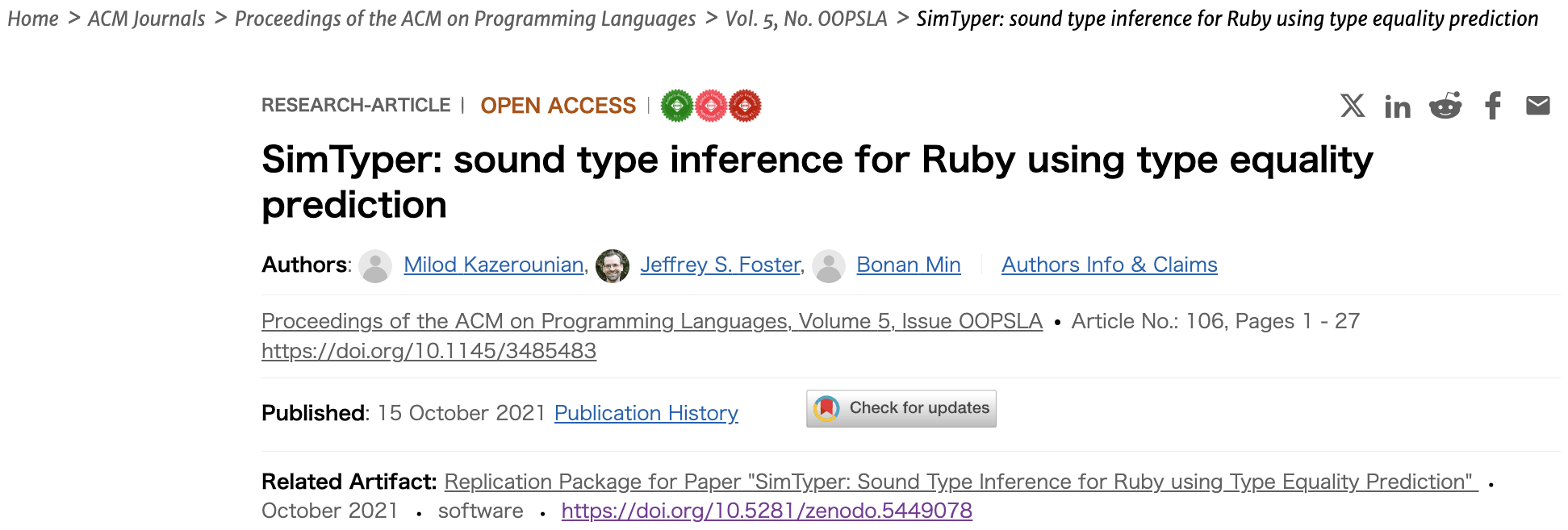
SimTyper - Evaluation Method
Compare expected and inferred types
for each argument, return value, and variable
def foo: (Array[String], Array[Integer]) -> Array[String]def foo: (Array[String], Array[String]) -> voidexpected:
inferred:
Match
Match
up to Parameter
Different
SimTyper - Test Data
SimTyper - Evaluation Result
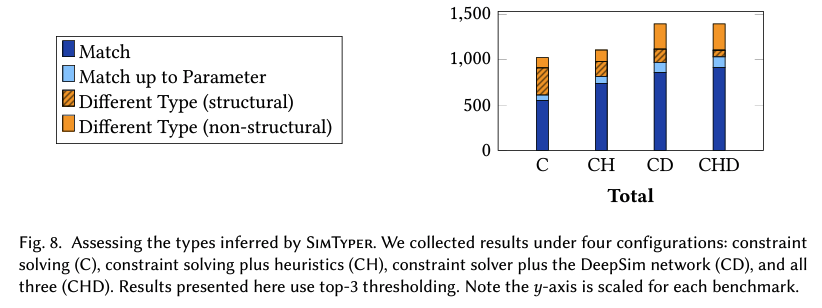
The number of matches can be compared for each method.
SimTyper - Artifacts
The reproducion data is provided
... as a VM image 😢
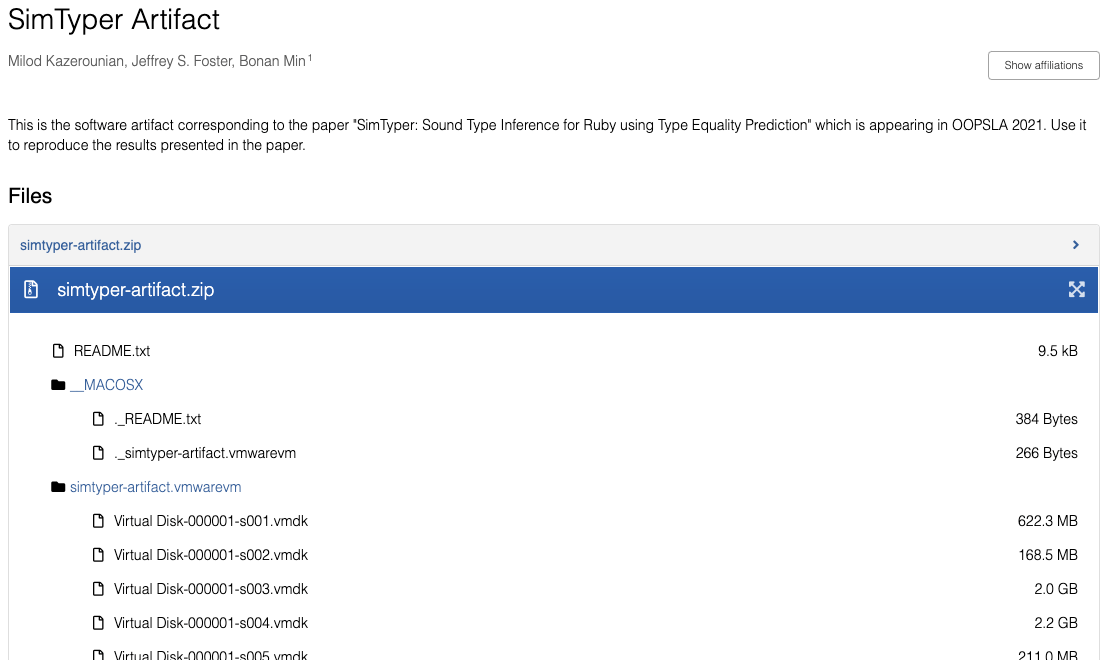
What we can learn from Study 1
-
Compare expected and inferred types and count matched
for each argument, return value, and variable
-
Ruby libraries and Rails applications are targeted
Practice-based results
Any repository with type declarations can be used
Even if it's Ruby, it's hard to use evaluation tools directly
TypeEvalPy - Abstract
-
Micro-benchmarks for type inference in Python
-
Small test cases, categorized by grammatical elements, etc.
-
-
Evaluation method is almost the same as SimTyper
-
compares for each parameter, return, and variable
-
only Exact matches counted
-
Venkatesh, TypeEvalPy: A Micro-benchmarking Framework for Python Type Inference Tools, 2023, ICSE 2024
Previous Study 2: TypeEvalPy
Venkatesh, TypeEvalPy: A Micro-benchmarking Framework for Python Type Inference Tools, 2023, ICSE 2024
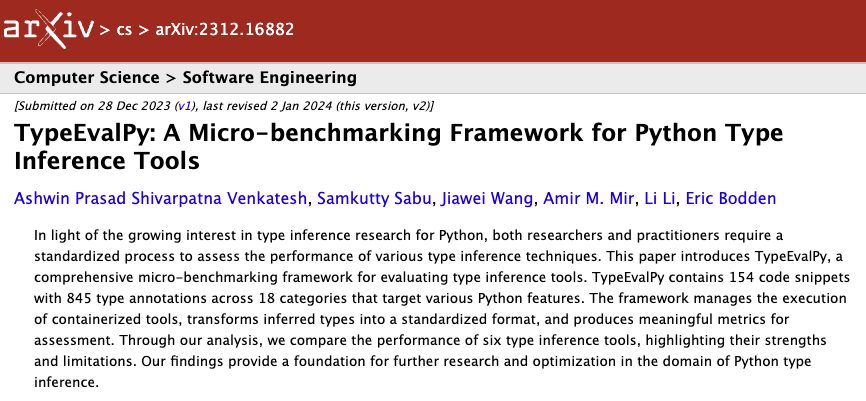
TypeEvalPy: TestCase Categories
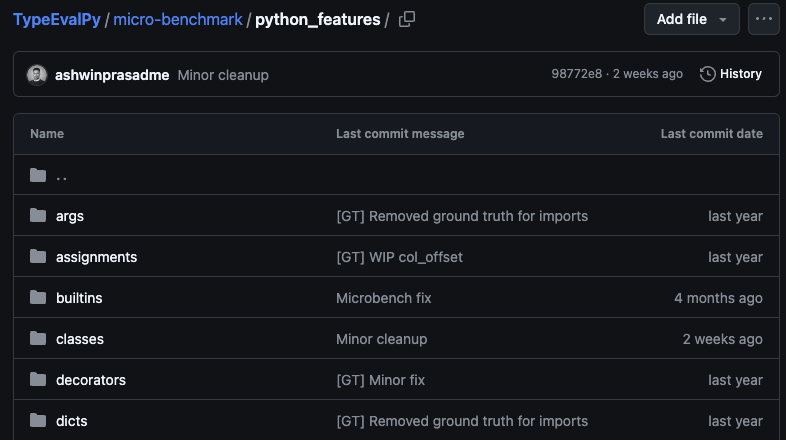
TypeEvalPy: TestCase
def param_func():
return "Hello from param_func"
def func(a):
return a()
b = param_func
c = func(b)main.py
[{"file": "main.py",
"line_number": 4,
"col_offset": 5,
"function": "param_func",
"type": ["str"]},
{"file": "main.py",
"line_number": 8,
"col_offset": 10,
"parameter": "a",
"function": "func",
"type": [ "callable"]},
// ...main_gt.json
TypeEvalPy: Benchmark Results
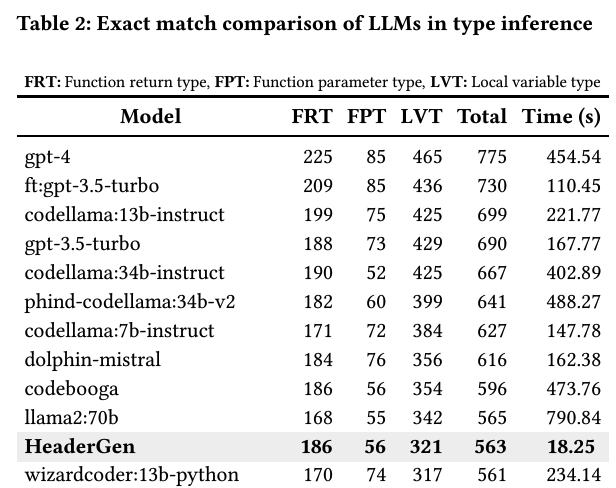
What we can learn from Study 2
-
Categorised test cases by grammar element, etc.
-
Aggregated by category to reveal strengths and weaknesses
-
-
Test case is small because it is a micro-benchmark
-
Possibility of deviation from practical performance
-
Based on these studies,
we will now consider how to evaluate RBS Goose's performance.
TypeEvalPy: Results
| Category | Total facts | Scalpel |
|---|---|---|
| args | 43 | 15 |
| assignments | 82 | 23 |
| builtins | 68 | 0 |
| classes | 122 | 24 |
| decorators | 58 | 19 |
...
Aggregate by category,
measure strengths and weaknesses.
What we can learn from Previous Studies
-
Compare expected and inferred types
-
for each argument, return value, and variable
-
The number of matches can be used as metrics
Two types of test data
-
Real-world code: measures practical performance
-
Micro benchmark: clarify the strengths and weaknesses
-
Outline
Basics of Type System and Type Inference
RBS Goose Architecture and Evaluation
Evaluation Method in Previous Studies
The idea of TypeEvalRb
Conclusion
Future Prospects in Ruby

Ruby+RBS Type Data Sets
(like ManyTypes4Py)

Provide Training Data
(Embed as examples)

Provide Data for evaluation
Type Benchmark
(like TypeEvalPy)
Evaluate
Develop data sets and benchmarks
to enable performance evaluation
Future Prospects in Ruby (2)

Generate type hints and Embed to prompts

RubyGems

Project Files

gem_rbs_collection
Collect Related Type Hints
TypeEvalRb - Architecture

Comparator
Test data
Expected RBS Types
Ruby Code

Inferred RBS Types

Benchmark Result
Aggregate
Match / Unmatch
TypeEvalRb - Comparation
-
Construct Comparison Tree from two
RBS::Environment-
Currently working on
-
-
Traverses Comparison Tree and Calcurate Match Count
-
Comparison is done per argument, return value, etc.
-
Classify as Match, Match up to parameters, or Different
-
TypeEvalRb - Comparation
Construct Comparison Tree from two RBS::Environment
# load expected/sig/bird.rbs to RBS::Environment
> loader = RBS::EnvironmentLoader.new
> loader.add(path: Pathname('expected/sig/bird.rbs'))
> env = RBS::Environment.from_loader(loader).resolve_type_names
=> #<RBS::Environment @declarations=(409 items)...>
# RBS::Environment contains ALL types includes stdlib, etc.
> env.class_decls.count
=> 330
# Extract Goose class
> goose = env.class_decls[RBS::Namespace.parse('::Goose').to_type_name]
=> #<RBS::Environment::ClassEntry:0x000000011e478d70 @decls=...>
TypeEvalRb - Comparation
Goose's ClassEntry is... so deeply nested 😅
> pp goose
#<RBS::Environment::ClassEntry:0x000000011f239a40
@decls=
[#<struct RBS::Environment::MultiEntry::D
decl=
#<RBS::AST::Declarations::Class:0x0000000128d7dd08
@annotations=[],
@comment=nil,
@location=
#<RBS::Location:371300 buffer=/Users/kokuyou/repos/type_eval_rb/spec/fixtures/examples/bird/refined/sig/bird.rbs, start=8:0, pos=61...105, children=keyword,name,end,?type_params,?lt source="class Goose < Bird">,
@members=
[#<RBS::AST::Members::MethodDefinition:0x0000000128d7dd58
@annotations=[],
@comment=nil,
@kind=:instance,
@location=
#<RBS::Location:371360 buffer=/Users/kokuyou/repos/type_eval_rb/spec/fixtures/examples/bird/refined/sig/bird.rbs, start=9:2, pos=82...101, children=keyword,name,?kind,?overloading,?visibility source="def cry: () -> void">,
@name=:cry,
@overloading=false,
@overloads=
[#<RBS::AST::Members::MethodDefinition::Overload:0x000000011f23a968
@annotations=[],
@method_type=
#<RBS::MethodType:0x0000000128d7dda8
@block=nil,
@location=
#<RBS::Location:371420 buffer=/Users/kokuyou/repos/type_eval_rb/spec/fixtures/examples/bird/refined/sig/bird.rbs, start=9:11, pos=91...101, children=type,?type_params source="() -> void">,
@type=
#<RBS::Types::Function:0x0000000128d7ddf8
@optional_keywords={},
@optional_positionals=[],
@required_keywords={},
@required_positionals=[],
@rest_keywords=nil,
@rest_positionals=nil,
@return_type=
#<RBS::Types::Bases::Void:0x0000000128892af0
@location=
#<RBS::Location:371440 buffer=/Users/kokuyou/repos/type_eval_rb/spec/fixtures/examples/bird/refined/sig/bird.rbs, start=9:17, pos=97...101, children= source="void">>,
@trailing_positionals=[]>,
@type_params=[]>>],
@visibility=nil>],
@name=#<RBS::TypeName:0x000000011f23abc0 @kind=:class, @name=:Goose, @namespace=#<RBS::Namespace:0x000000011f23abe8 @absolute=true, @path=[]>>,
@super_class=
#<RBS::AST::Declarations::Class::Super:0x000000011f23a9e0
@args=[],
@location=
#<RBS::Location:371540 buffer=/Users/kokuyou/repos/type_eval_rb/spec/fixtures/examples/bird/refined/sig/bird.rbs, start=8:14, pos=75...79, children=name,?args source="Bird">,
@name=
#<RBS::TypeName:0x000000011f23b160 @kind=:class, @name=:Bird, @namespace=#<RBS::Namespace:0x0000000100cdf6a8 @absolute=true, @path=[]>>>,
@type_params=[]>,
outer=[]>],
@name=#<RBS::TypeName:0x000000011f239a68 @kind=:class, @name=:Goose, @namespace=#<RBS::Namespace:0x000000011f23abe8 @absolute=true, @path=[]>>,
@primary=nil>TypeEvalRb - Comparation
Take only defined classes and build a tree structure (lack many things)
> compare_bird
=>
ComparisonTree(
class_nodes=[
ClassNode(typename=::Bird, instance_variables=[ ], methods=[ ])
ClassNode(typename=::Duck,
instance_variables=[ ],
methods=[
MethodNode(name=cry, parameters=[ ],
return_type=TypeNode( expected="void", actual="untyped")
)])
ClassNode(typename=::Goose,
instance_variables=[ ],
methods=[
MethodNode(name=cry, parameters=[ ],
return_type=TypeNode( expected="void", actual="untyped")
)])
])TypeEvalRb - Test Data
-
Micro-benchmark data like TypeEvalPy
-
Small test data classified by grammatical elements, etc.
-
For detailed evaluation of strengths and weaknesses
-
-
Real-world data, similar to that used to evaluate SimTyper
-
Libraries and Rails applications with RBS type definitions
-
For evaluation of practical performance
-
TypeEvalRb - Microbenchmark Test Data
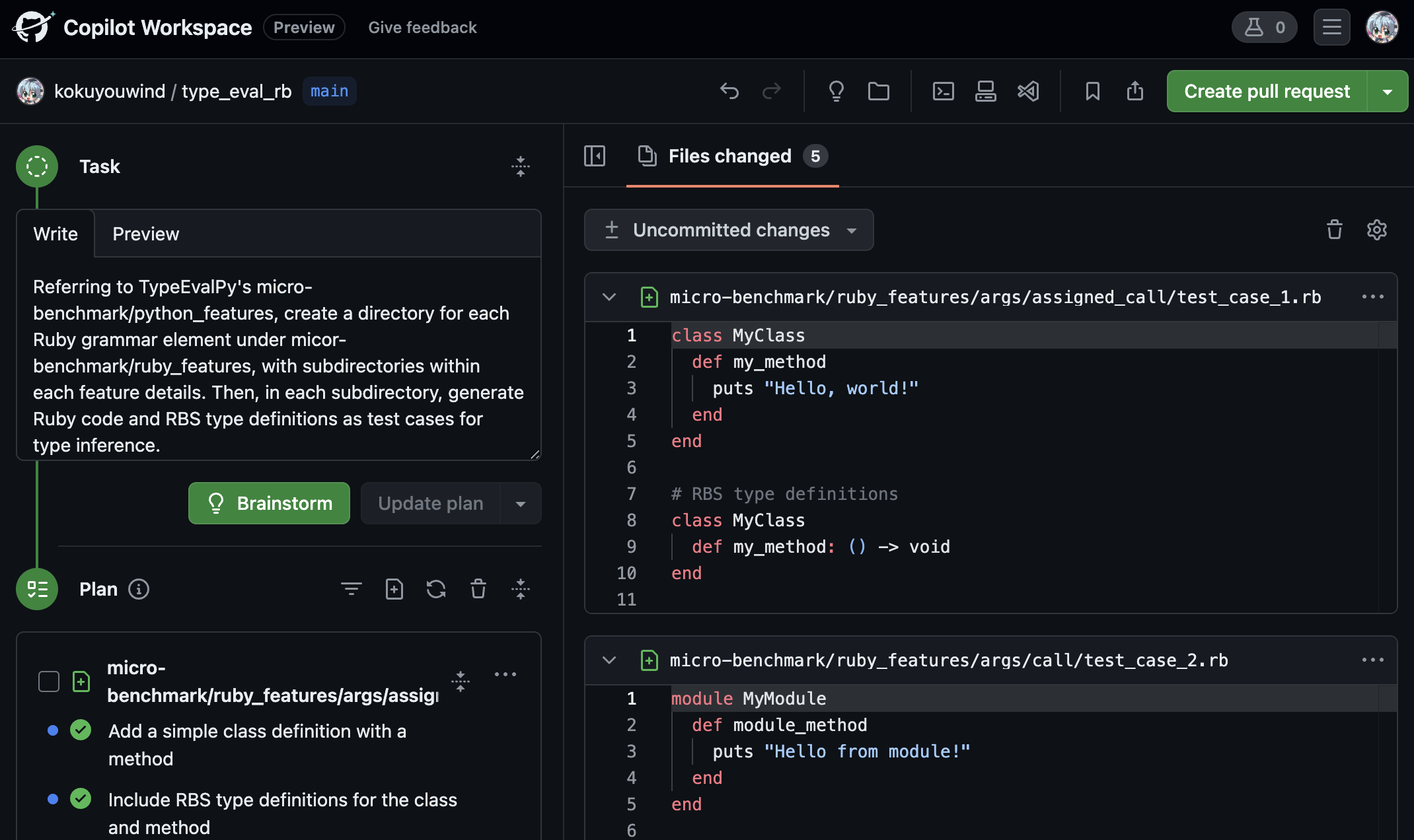
Exploring the possibility of
using the GitHub Copilot Workspace for data preparation.
TypeEvalRb

Work in Progress
Outline
Basics of Type System and Type Inference
RBS Goose Architecture and Evaluation
Evaluation Method in Previous Studies
The idea of TypeEvalRb
Conclusion
Conclusion
-
Shared how RBS Goose works and evaluation results
-
Better results than traditional methods in some cases
-
-
Surveyed evaluation methods in previous studies
-
Count matches between expected and inferred types
-
Both Micro-Benchmark and real-world data are useful
-
-
Shared idea of TypeEvalRb, type inference benchmark
-
To reveal inference performance and for future improvement
-
Preliminary Slides
What is LLM?
Large language model (LLM) is
"Large" "Language Model".
Language Model (LM)
A model assigns probabilities to sequence of words.
["The", "weather", "is"]
A model assigns probabilities to sequence of words.
(50%) "sunny"
(20%) "rainy"

Language Model
(0%) "duck"
"Large" Language Model
The amount of pre-training data size and the model size are “large”.




Pre-training
Pre-training
(non-large) LM
Large Language Model
"Large" Language Model

Considerations for LLMs
-
Because LLMs are one type of language model,
LLM generate text probabilistically.-
Inference process is unclear
-
Sometimes they output "plausible nonsense" (hallucinations)
-
Papers Found
-
Found many previous papers
-
Today I pick up two papers
-
Measured the type inference capability of LLMs
-
Improvement with Chain of Thought Prompts
-
Paper 1. Measured the type inference capability
Ashwin Prasad Shivarpatna Venkatesh,
The Emergence of Large Language Models in Static Analysis: A First Look through Micro-Benchmarks, 2024, ICSE FORGE 2024
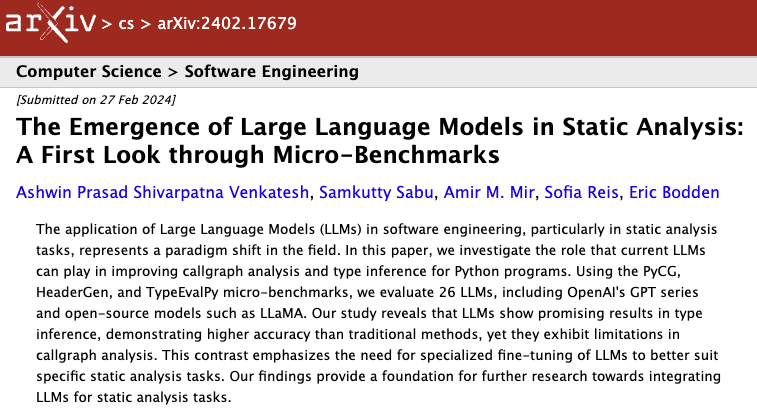
Paper 1. Abstruct
-
Evaluate LLM type inference accuracy in Python
-
LLMs showed higher accuracy than traditional methods
-
-
TypeEvalPy is used as a micro-benchmark for type inference
-
Comparing the inferred types with the correct data
(Function Return Type, Function Parameter Type, Local Variable Type)
-
Paper 1. Prompt
Simple few-shot Prompt
Input: Python code
Output: JSON
You will be provided with the following information:
1. Python code. The sample is delimited with triple backticks.
2. Sample JSON containing type inference information for the Python code in
a specific format.
3. Examples of Python code and their inferred types. The examples are delimited
with triple backticks. These examples are to be used as training data.
Perform the following tasks:
1. Infer the types of various Python elements like function parameters, local
variables, and function return types according to the given JSON format with
the highest probability.
2. Provide your response in a valid JSON array of objects according to the
training sample given. Do not provide any additional information except the JSON object.
Python code:
```
def id_func ( arg ):
x = arg
return x
result = id_func (" String ")
result = id_func (1)
```
inferred types in JSON:
[
{
"file": "simple_code.py",
"function": "id_func",
"line_number": 1,
"type": [
"int",
"str"
]
}, ...Python Code
Specify Output Format (JSON)
Instruction
Paper 1. Results
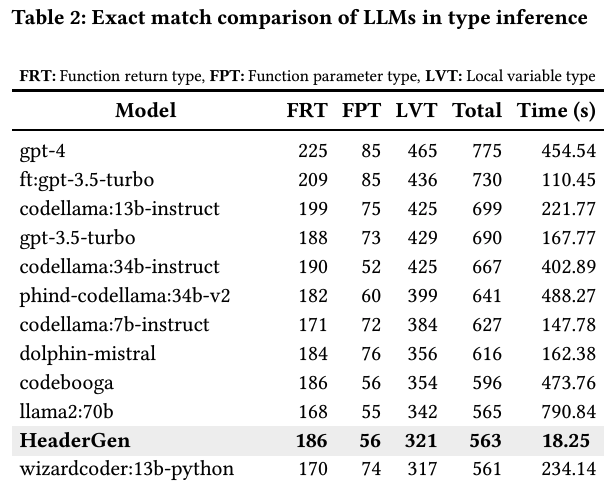
GPT-4
Score: 775
Time: 454.54
Traditional Method
Score: 321
Time: 18.25
Paper 1. What We Can Learn
-
Benchmarks for type inference exist, such as TypeEvalPy
-
Provide consistent metrics for type inference capability
-
Ruby also needs benchmarking
-
-
Even Simple prompt can have a higher inference capability
-
Note that micro-benchmarks favor LLMs
-
Both time and computational costs are high
-
Paper 2. Improvement with Chain of Thought
Yun Peng, Generative Type Inference for Python, 2023, ASE' 23
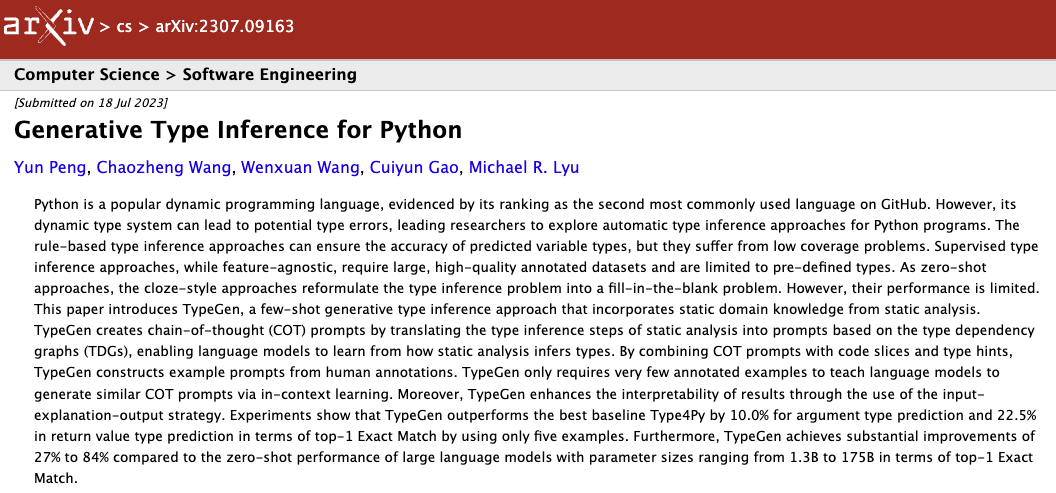
Paper 2. Abstruct
-
Chain of Thought (COT) prompts can be used for type inference
-
Improved 27% to 84% compared to the zero-shot prompts
-
-
ManyTypes4Py is used for training and evaluation
-
Dataset for Machine Learning-based Type Inference
-
80% to Training, 20% to Evaluation
-
Measure Exact Match and Match Parametric in Evaluation
-
Paper 2. Architecture

COT Prompt Construction
Training Data is used
as an example
Generate Type Hints
Paper 2. Prompt
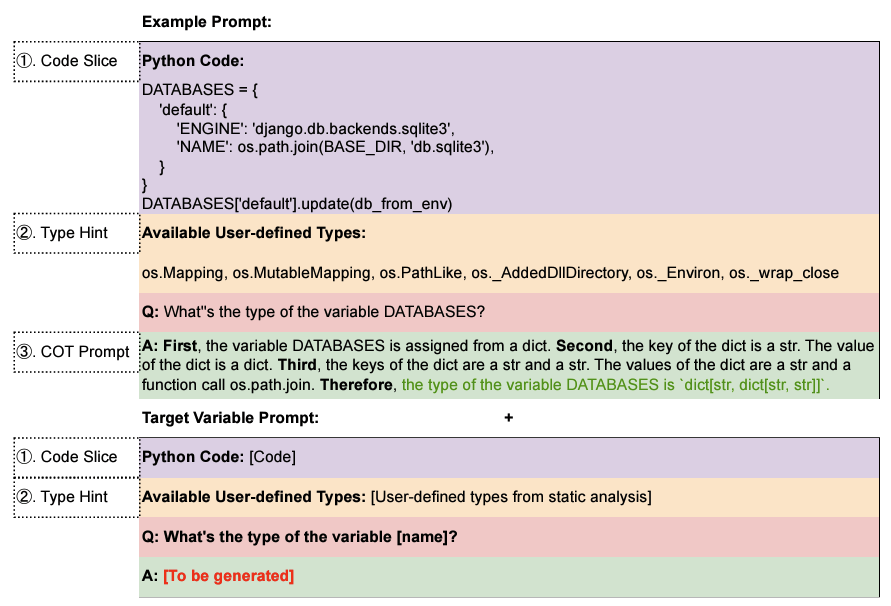
Embedded type derivation process with COT
Embedded type hints
Embedded examples
Paper 2. Results


28-29% improved
than Zero-Shot
in ChatGPT
Paper 2. What We Can Learn
-
What information is embedded in the prompt is important
-
Add Type Hints
-
Use chain of thought prompts
-
-
Type data sets like ManyTypes4Py are useful
-
Can be used as an example prompt as well as for evaluation
-
Prospective of Type Benchmark - Considerations
-
Currently, rbs-inline is under development [*]
-
it allows type descriptions within special inline comments
-
Similar to YARD documentation
-
-
Might need to support
-
RBS Goose Input / Output
-
Benchmark Test Data / Comparator
-
Do LLMs dream of Type Inference?
By 黒曜
Do LLMs dream of Type Inference?
Session of RubyConf 2024
- 686



